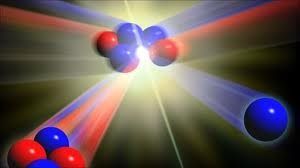Jun 26, 2019
The NASA Orbiter That Turned Lunar Science On Its Head
Posted by Bruce Dorminey in category: science
Now ten years into its mission and counting, NASA’s Lunar Reconnaissance Orbiter has pretty much turned lunar science on its head.
Now ten years into its mission and counting, NASA’s Lunar Reconnaissance Orbiter has pretty much turned lunar science on its head.
Particle physicists might seem like a dry bunch, but they have their fun. Why else would there be such a thing as a “strange quark”? When it comes to the fundamental nuclear forces, though, they don’t mess around: the strongest force in nature is known simply as the “strong force,” and it’s the force that literally holds existence together.
Public access site for The Wilkinson Microwave Anisotropy Probe and associated information about cosmology.
We can never see these more distant regions. Still, the observable Universe alone should be big enough for most people. Indeed, for scientists like Casey and Sheth, it remains a constant source of fascination.
We’re not even at the centre of our Solar System or at the centre of our galaxy
“Everything that we’ve learned about the Universe – how big it is, all the amazing objects that are in it – we do that simply by collecting these photons of light that have travelled millions and millions of light years only to come and die on our detectors, our cameras or radio telescopes,” says Sheth.
Small fusion is very possible as fusion is a nuclear process that scales elegantly.

Sometime in the not distant future that we may see the practical development of successful small fusion reactors. Even integrated circuit scale pure fusion reactors may be possible.
The universe will cease to exist around the same time our sun is slated to die, according to new predictions based on the multiverse theory.
Andrei Linde, the Harald Trap Friis Professor of Physics at Stanford University, will give the Applied Physics/Physics colloquium on Tues., May 8, 2018 entitled “Reverse Engineering the Universe.” This lecture will be held in the Hewlett Teaching Center, Room 200.
Event Sponsor:
Applied Physics/Physics Colloquium
From harnessing the power of a black hole to giving stars a nudge, the prospect of playing with solar systems puts our engineering feats on Earth into perspective.
Circa 2014
One second after the Big Bang, the Higgs boson should have caused a Big Crunch, collapsing the universe to nothing. But gravity saved the day.
